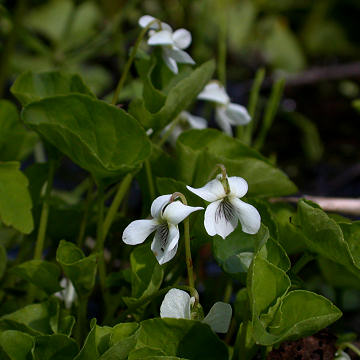

Viola blanda - (image 1 of 5)
Taxonomy
Family: Violaceae
Habitat
Moist, shaded woods in deep organic soil.
Associates
Often found under evergreens.
Distribution
Most of the northeastern U.S.
Morphology
Herbaceous perennial. Leaves all basal, broad, longer than wide, cordate at base with a deep, narrow basal sinus; petioles and peduncles red-tinged. Flowers white, beardless, the three lower petals striped with purple at the base, the upper two reflexed.
Some of these differences between this species and the very similar V. macloskeyi. Note the flower in the last image does not have reflexed upper petals but was from the same colony as the rest of these images, which illustrates how difficult it can be to separate the two species based on photographs.
V. blanda -Leaves deeply lobed at the base. Upper two petals reflexed and twisted; lateral two petals pointing forward. Petioles and peduncles reddish. Seed capsule green. Deep organic soil under conifers.
V. macloskeyi - Leaves more shallowly lobed. Upper two petals not (or slightly) reflexed, not twisted; lateral two petals straighter and more spreading. Seed capsule purple. Springy soil, often in shallow water.
Notes
Flowers April to May
Wetland indicator: Facultative wetland
Flowers often fragrant. Grows from slender rhizome. The USDA plants database lists var. palustriformis A. Gray as being native to the Chicago region, while Swink and Wilhelm would call this plant V. incognita Brainard, or hairy white violet. This variety or species has thinly to densely bearded lateral petals and is considered endangered in Illinois.
References
Gleason, Henry A. and A. Cronquist. 1991. Manual of Vascular Plants of Northeastern United States and Adjacent Canada. Second Ed.
The New York Botanical Garden. Bronx, NY
Swink, F. and G. Wilhelm. 1994. Plants of the Chicago Region.
Indiana Academy of Science. The Morton Arboretum. Lisle, Illinois.
USDA, NRCS. 2002. The PLANTS Database, Version 3.5 (http://plants.usda.gov).
National Plant Data Center, Baton Rouge, LA 70874-4490 USA.
|
Michael Hough © 2005 |